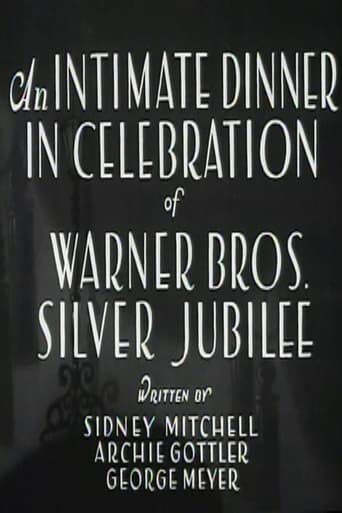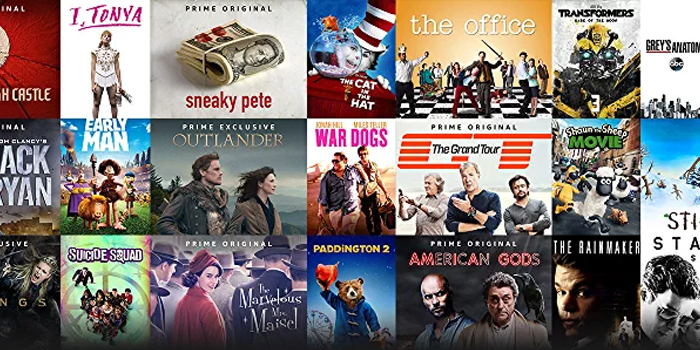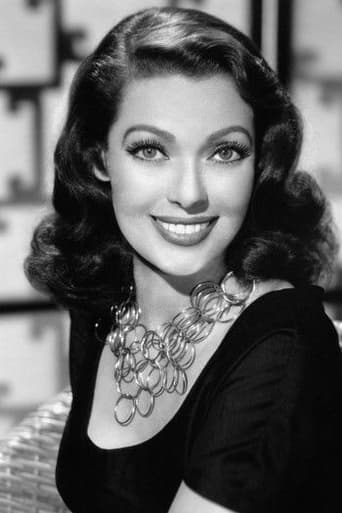

An Intimate Dinner in Celebration of Warner Bros. Silver Jubilee (1930)
Mr. and Mrs. Warner Bros. Pictures and their precocious offspring, Little Miss Vitaphone, host a dinner in honor of Warner Bros. Silver Jubilee, attended by most of the major players and song writers under contract to WB at that time.
Watch Trailer
Cast
Reviews
Very disappointing...
People are voting emotionally.
best movie i've ever seen.
Great movie! If you want to be entertained and have a few good laughs, see this movie. The music is also very good,
Warner's Intimate Dinner is a historic curio indeed. The phony Mr. and Mrs. Warner Brothers Pictures yields to baby Vitaphone, who then proceeds to provide publicity to each actor and actress seated at the dinner table. Little miss Vitaphone introduces them one by one or in pairs as they appeared in their own or each other's films at the time. A high majority of the "stars" at the celebration weren't really stars at all but were just starting their film careers or had only a few movies under their belts at the time. This includes even Edward G. Robinson, who is referred to without the "G" here. Many of those present worked only a few years in films before flaming out, including the director of this piece. An unexpected but pleasant surprise is seeing the several composers appear who weren't really tied to Warner Brothers, so one can only wonder why they made appearances here. Due to to the talent involved, or in some cases, the lack of it, it seems as if this film is simply a shameless excuse to promote new talent for Warner Brothers, especially considering the fact this was no where near Warner's 25th anniversary.
Intimate Dinner in Celebration of Warner Bros. Silver Jubilee, An (1930) *** (out of 4) The 25th Anniversary of Warner Bros. is documented here with a party thrown that included many of the studios biggest stars at the time. Loretta Young, Edward G. Robinson, Walter Pidgeon, Douglas Fairbanks, Jr., Walter Huston, David Manners and Joe E. Brown are just some of the famous faces at the party. Each are introduced and often times their next movie is mentioned for some free press.You can view this historic short on disc 3 of Warner's The Jazz Singer set.
I'm giving this short subject a few points more than it deserves, because there are some faces in it that one rarely if ever saw or heard in early talkies. Among them are Broadway stars Otis Skinner (see OUR HEARTS WERE YOUNG AND GAY and KISMET), and Marilyn Miller, as well as young Richard Rodgers, Lorenz Hart, Sigmund Romberg, Oscar Hammerstein II, Al Dubin, and such faces as Walter Huston, Frank McHugh, Joan Blondell, Edward G. Robinson, Walter Pidgeon, Loretta Young, Sidney Blackmer, and Ona Munson. I can even add the Fred Kohler Sr. and Beryl Mercer. It's pleasant seeing faces of some importance or still vibrant memory there.But having said that I look at the bulk of the celebrities. The chief spokesperson is a young girl, Betty Jane Graham, as "Little Miss Vitaphone". Vitaphone, of course, was the process that the Warners used to bring talkies to Hollywood. Ms Graham is polite and well spoken. She is a pretty child. That said, there has absolutely no spark of talent or panache in her. If you check the thread on her, she had a career into the 1940s, but increasingly it fell into not even supporting parts but extras. Finally she must have gotten the message and left films entirely.I have heard of Evelyn Knapp (barely) and Louis Fazenda, but who on earth are Leon Janney (any relation to television star Alison Janney?), Claudia Dell, or James Rennie? The stars of tomorrow. Their credits barely suggest anything.In the other comments on this thread, there are complaints that the brothers Warner failed to use such figures as George Arliss, Richard Barthelmess, or (my God, how could they?!) John Barrymore. Yes, indeed, they did. They also did not bring in their champion man of song Mr. Al Jolson. A song is sung at the end by some well intentioned crooner with a forgettable name, who looks like he's got a great future in half-empty concert halls. He is warbling a slightly passable ditty with words by Mr. Dubin. As I listened to him sing this, and saw Ms Miller was in that room, I wanted to cry. The tune is not a standard, but with a bit of friendly or sexy push it might have been. Or if Mr. Jolson had been around it might have been.I take it this was done as publicity (to show off some of the big and so-called promising names) for the studio. As such they may have grabbed whoever was available (due to shooting schedules) on that day or two it was shot. So, as a museum piece it is curious enough to merit a "7" out of generosity to Otis and Marilyn in particular. But otherwise I felt like a lot of good film stock was wasted in this work.
This short subject, nominally in celebration of Warner Brothers' silver jubilee -- the only thing I can think of is that they may have opened their first theater in 1905; they didn't go into production for another dozen years -- is an excellent primer for putting faces to names. If you are a fan of old movies, you have seen these actors, but you may not be able to link the faces with the names.Besides the players, various composers and lyricists are shown. It is amusing, given what happened later, to see Richard Rogers and Oscar Hammerstein II -- but they are seated next to, respectively, Lorenz Hart and Sigmund Romberg.This is not, otherwise, an interesting short subject --the moviegoer was intended to be overwhelmed by the sight of so much talent and probably was. Now it is simply a historical artifact.


